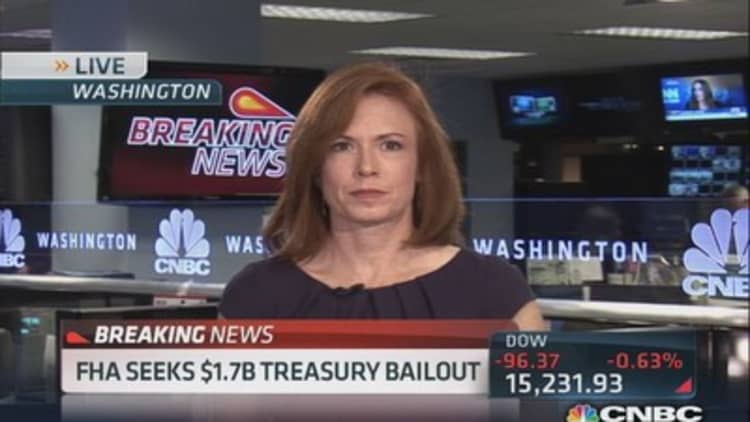
The Federal Housing Administration, the government insurer of low down-payment loans, told Congress on Friday it needs $1.7 billion from the Treasury to pad its insurance fund. This is higher than expected, due to the fact that FHA is now insuring fewer loans.
"This amount is higher than the estimate provided in the president's budget because of a decline in FHA endorsement volume in the last few months of the fiscal year—consistent with the trend in the broader housing market in response to higher interest rates," FHA Commissioner Carol Galante wrote in the request to Congress.
This is the first time in the FHA's 79-year history that it has required money from taxpayers for its Mutual Mortgage Insurance Fund (MMIF). The letter is a courtesy, as the FHA has budget authority and does not need congressional approval.
(Read more: Pending home sales fall in August)
The bailout is a far cry from the nearly $200 billion that mortgage giants Fannie Mae and Freddie Mac required to stay afloat during the housing crisis; some are even calling it an accounting technicality.
"The draw is a mandatory draw, even though they will likely never need it based on real performance," noted David Stevens, a former FHA commissioner and now president and CEO of the Mortgage Bankers Association. "The FHA is producing the most profitable loans ever. The OMB budget as well as the CBO budget reflect that the past few book years are producing billions in 'negative subsidy,' meaning profit, to the Treasury."
The draw is based on estimates of its insurance fund from December, which include how loans are expected to perform—but the accounting system doesn't factor in changes in the market during this past year. Those include a big jump in home prices, a sharp drop in delinquencies and higher premiums FHA is now charging.
The negatives, however, are that the FHA is making far fewer loans today due to tighter underwriting and higher fees. That means it is making less money, even though its newer loans are performing extremely well. The estimates for the insurance fund will not be updated until the end of this year, when it will likely show vast improvement.
(Read more: Mortgage alert: Borrowers change how they cheat)
"It is estimated that the improvement in recovery rates alone is worth more than $5 billion to the MMIF—which would far exceed the amount of the mandatory appropriation," wrote Galante.
The FHA, which insures low down-payment loans, or loans with a minimum 3.5 percent down, stepped in to save the housing market. It went from about a 3 percent share of the market to almost a third of the mortgage market during the crash. But now, it's paying the price.
"Over the years, the FHA has strayed far from its original mission. It has become the nation's largest subprime lender," wrote Rep. Jeb Hensarling, R-Texas, chairman of the House Financial Services Committee.
(Read more: Map: Tracking the recovery)
Most of the FHA losses, around $70 billion, were from loans originated between 2007 and 2009. The biggest trouble has been in reverse-mortgages for senior citizens and seller-funded down payments; the latter was banned in 2008.
—By CNBC's Diana Olick. Follow her on Twitter @Diana_Olick.
Questions?Comments? facebook.com/DianaOlickCNBC



